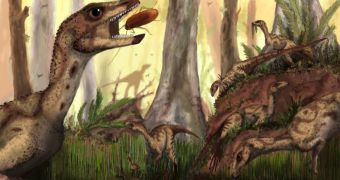A paper published in yesterday's issue of the journal Proceedings of the Royal Society B announces the discovery of the fossilized remains of four dinosaurs belonging to a previously undocumented species in present-day Venezuela.
Paleontologists who have had the chance to study these remains believe them to be about 200 million years old. By the looks of it, the bones were left behind by two-legged creatures no bigger than modern foxes.
As detailed in the journal Proceedings of the Royal Society B, these creature and others of their kind measured about 3 feet (roughly 1 meter) in length, and approximately 1 foot (0.3 meters) in height, Live Science informs.
Based on data obtained while examining the dinosaurs' teeth, specialists suspect that, although they mostly ate plants, they did not shy away from feasting on creatures they shared their habitat with every once in a while. These creatures were likely insects.
“The teeth are very unusual, with a tall, narrow triangular outline, tips that are slightly curved backward, coarse serrations along the margins and thin ridges that extend up and along the crown,” says specialist Paul Barrett with the Natural History Museum in London.
“Although the triangular shape and coarse serrations suggest that plants made up most of the diet, the tall outline is reminiscent of meat-eating teeth, as are the slightly curved tips, so it is possible that they took small prey such as large insects some of the time,” he adds.
Since the fossilized remains of these four ancient creatures were all unearthed in the same location, it is believed that these dinosaurs used to live in herds. Chances are that this made it easier for them to populate regions that were too inhospitable for such animals to be able to survive on their own.
This newly-discovered dinosaur species that roamed the Earth in the earliest part of the Jurassic period is now known to the scientific community as Laquintasaura venezuelae. Given its anatomy, specialists believe it to be a relative of two other species, i.e. Stegosaurus and Triceratops.
Interestingly enough, specialists say that Laquintasaura venezuelae walked the Earth about 500,000 years after a mass extinction that boiled down to the loss of about 50% of the species inhabiting the planet. It is this mass extinction that researchers suspect made it possible for these creatures to thrive.
“In many ways, this extinction was a major help to dinosaurs, as it killed off a number of other reptile groups that might have been competitors. Laquintasaura is known only 500,000 years after the extinction, and shows that ornithischians [i.e. an order of dinosaurs] were quick off the mark during this recovery period,” explains Paul Barrett.

 14 DAY TRIAL //
14 DAY TRIAL //